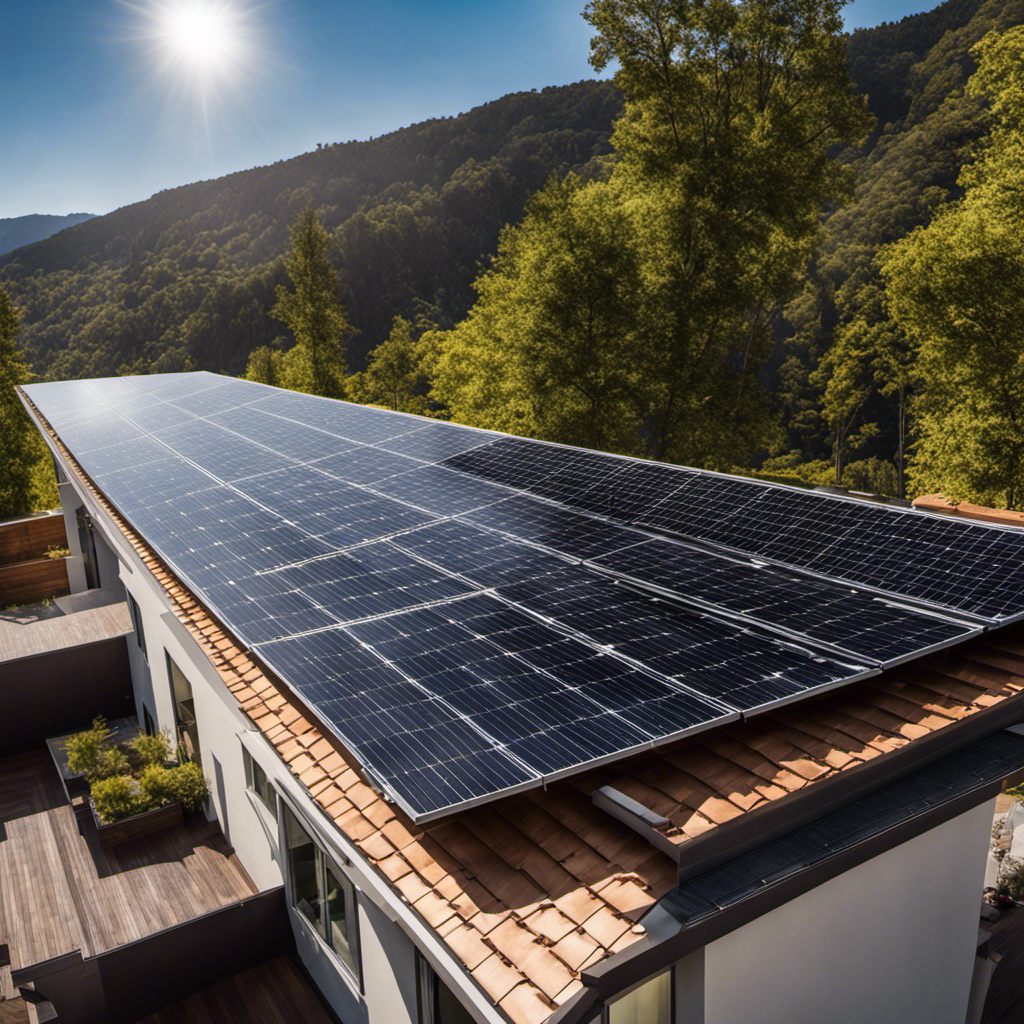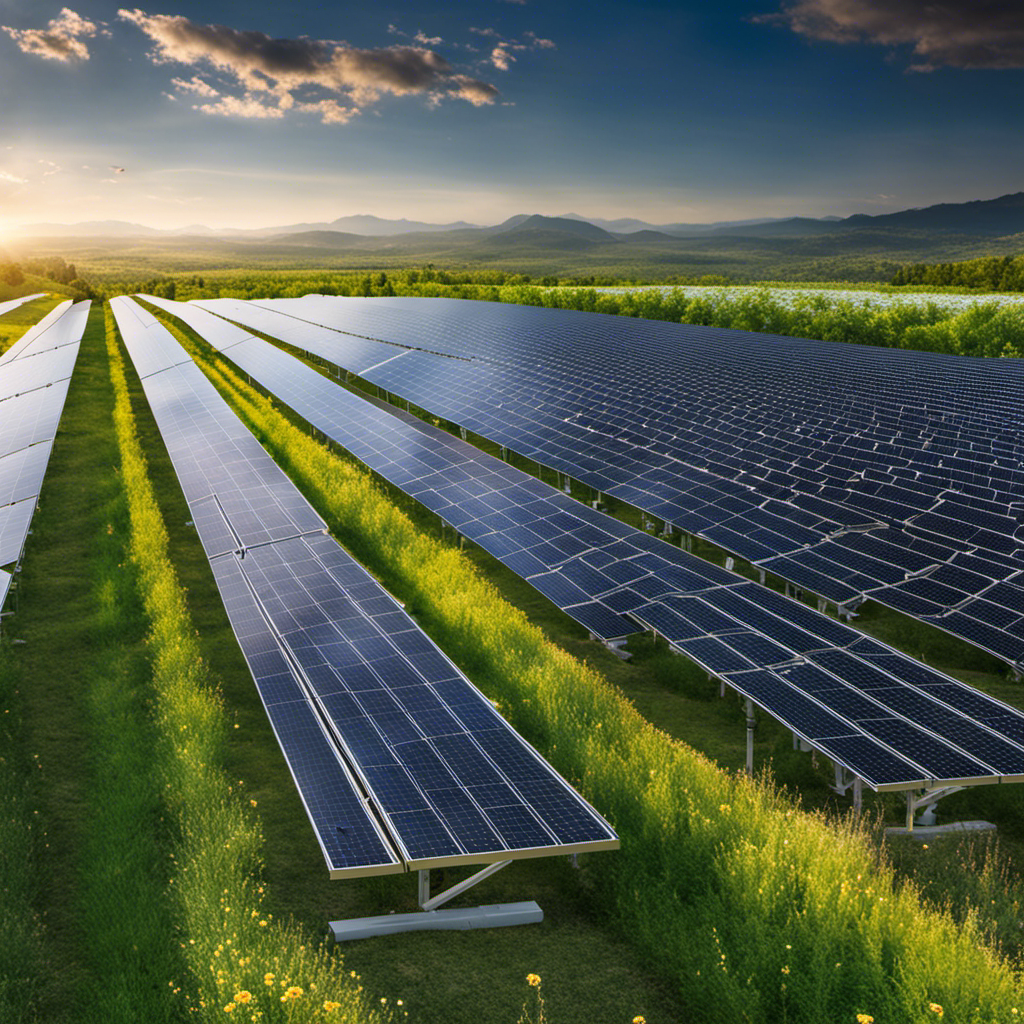Solar
Enhancing Solar Panel Efficiency: Technologies and Strategies

I have always been intrigued by the untapped potential of solar panels as a solar energy enthusiast.
In this article, we delve into the world of enhancing solar panel efficiency through cutting-edge technologies and strategic approaches.
From advanced materials to tracking systems and optimized placement, we explore the innovations driving the industry forward.
With the integration of energy storage, we unlock new levels of efficiency.
Join me on this journey as we uncover the possibilities and push the boundaries of solar power generation.
Key Takeaways
- Nanostructured coatings and quantum dot technology can enhance the absorption and conversion of sunlight, improving solar panel efficiency.
- Tracking systems and regular cleaning are important for maintaining high efficiency by allowing panels to follow the sun’s path and removing debris that can reduce performance.
- Optimizing solar panel placement and orientation, including considering tilt angles and avoiding shading, greatly impacts efficiency.
- Integration of energy storage systems, such as batteries and pumped hydro storage, can maximize the utilization of renewable energy resources and ensure a continuous supply of electricity.
Advanced Materials for Solar Panels
I’m excited to learn about the potential of advanced materials in improving solar panel efficiency.
One promising technology is the use of nanostructured coatings. These coatings consist of thin layers of materials with nano-sized features, which can enhance the absorption and conversion of sunlight into electricity. By carefully designing the nanostructure of these coatings, we can control the light absorption and reflection properties, maximizing the efficiency of solar panels.
Another exciting development is quantum dot technology. Quantum dots are tiny semiconductor particles that can be tuned to absorb specific wavelengths of light. By incorporating quantum dots into solar panels, we can expand their light absorption range and improve their overall efficiency. The unique properties of quantum dots, such as their size-dependent bandgap, make them ideal for enhancing solar panel performance.
Through further research and development, these advanced materials hold great promise for revolutionizing the efficiency of solar panels.
Tracking Systems for Optimal Sunlight Capture
To achieve optimal sunlight capture, using tracking systems is crucial. These systems allow solar panels to follow the sun’s path throughout the day, maximizing the amount of sunlight they receive.
However, to maintain high efficiency, regular maintenance is necessary. Solar panel cleaning techniques play a vital role in ensuring maximum sunlight absorption. Dust, dirt, and debris can accumulate on the surface of the panels, reducing their efficiency. Cleaning them regularly helps to remove these obstructions and maintain their performance.
Additionally, weather conditions can also impact solar panel efficiency. Cloudy or overcast days can significantly reduce the amount of sunlight reaching the panels, resulting in decreased energy production. Therefore, it’s essential to consider weather patterns and conditions when designing and implementing solar tracking systems.
Optimizing solar panel placement and orientation is the next crucial step to further enhance their efficiency.
Optimizing Solar Panel Placement and Orientation
When considering optimal sunlight capture, one important factor to take into account is the placement and orientation of the solar panels. The tilt angle of the solar panels plays a crucial role in maximizing their performance. Different tilt angles are recommended depending on the geographical location. For example, in locations closer to the equator, a tilt angle equal to latitude is often considered optimal. However, in regions with higher latitudes, a steeper tilt angle may be necessary to capture more sunlight throughout the year. Additionally, shading can have a significant impact on solar panel performance. It is important to avoid any shading on the panels, as even a small amount of shading can decrease the overall efficiency of the solar array. Proper placement and orientation, along with careful consideration of tilt angles and shading, can greatly enhance the efficiency of solar panels.
| Tilt Angle | Optimal Latitude |
|---|---|
| 0 degrees | 0-5 degrees |
| 30 degrees | 15-25 degrees |
| 45 degrees | 30-50 degrees |
Innovations in Solar Panel Design and Manufacturing
Innovations in solar panel design and manufacturing have revolutionized the industry, making renewable energy more accessible and efficient.
One significant aspect of these innovations is the focus on solar panel aesthetics and architectural integration. Manufacturers are now producing panels that blend seamlessly with the surrounding environment, allowing for more versatile and aesthetically pleasing installations. This integration not only enhances the visual appeal of solar panels but also encourages their adoption in urban and residential areas.
Another area of advancement is the improvement in solar panel durability and lifespan. Manufacturers are using advanced materials and techniques to make panels more resistant to environmental factors such as extreme temperatures, humidity, and even hailstorms. This increased durability ensures that solar panels can withstand harsh conditions and continue to generate electricity for an extended period, maximizing their return on investment.
These innovations in solar panel design and manufacturing pave the way for the integration of energy storage for increased efficiency. By combining solar panels with energy storage systems, excess energy can be stored and used during periods of low sunlight, reducing reliance on the grid and further optimizing the utilization of renewable energy resources.
Integration of Energy Storage for Increased Efficiency
The integration of energy storage systems maximizes the utilization of renewable energy resources, allowing me to store excess energy for use during periods of low sunlight. This is a crucial aspect of energy management and grid integration. By incorporating energy storage technologies into solar panel systems, we can overcome the intermittent nature of solar energy and ensure a continuous supply of electricity. These energy storage systems, such as batteries or pumped hydro storage, store the surplus energy generated by solar panels during peak sunlight hours and release it when needed. This enables a more efficient use of renewable energy and reduces reliance on traditional power sources. The table below highlights the benefits of integrating energy storage systems into solar panel installations:
| Benefits of Energy Storage Integration |
|---|
| Increased self-consumption of solar energy |
| Improved grid stability and reliability |
| Ability to shift excess energy to peak demand periods |
| Reduced reliance on fossil fuels |
Frequently Asked Questions
How Do Solar Panels Work?
Solar panels work by converting sunlight into electricity through the use of photovoltaic cells. These cells absorb photons from the sun and generate an electric current. The design and efficiency of solar panels play a crucial role in maximizing energy production.
What Are the Different Types of Solar Panels Available in the Market?
There are many different types of solar panels available in the market. Factors such as efficiency and advancements play a crucial role in choosing the right solar panel for your energy needs.
What Are the Environmental Benefits of Using Solar Panels?
Using solar panels in the manufacturing process significantly reduces greenhouse gas emissions, making it an environmentally friendly choice. They have a positive impact on reducing our carbon footprint and help combat climate change.
Can Solar Panels Generate Electricity During Cloudy or Rainy Days?
During cloudy or rainy days, solar panels can still generate electricity, albeit at a reduced efficiency. However, with advancements in technology and the use of alternative energy sources, we are constantly overcoming these limitations and enhancing solar panel performance.
How Long Do Solar Panels Typically Last and What Is Their Maintenance Requirement?
Solar panels typically last for 25 to 30 years with proper maintenance. Regular cleaning, inspection for damage or debris, and occasional repairs ensure optimal performance. Maintenance needs may vary depending on factors like climate and installation location.
Conclusion
In conclusion, the continuous advancements in technology and strategies for enhancing solar panel efficiency have shown great promise. With the use of advanced materials, tracking systems, optimized placement and orientation, innovative designs, and integration of energy storage, we can maximize energy capture and utilization.
As the saying goes, ‘Every cloud has a silver lining,’ the future of solar power looks bright, offering a sustainable and environmentally friendly solution for meeting our energy needs.
Solar
The Role of Solar Power in Air Pollution Reduction

As a strong supporter of clean air, I am excited to investigate the impactful role that solar power plays in decreasing air pollution. Like a beacon of hope cutting through the polluted sky, solar energy provides a sustainable solution to address harmful emissions.
With its remarkable ability to harness the power of the sun, solar power not only contributes to cleaner air but also helps alleviate the pressing issue of air pollution.
Let’s delve into the data-driven advantages of solar energy and its potential to create a brighter, healthier future for all.
Key Takeaways
- Solar power reduces air pollution-related deaths by up to 80%.
- Solar energy helps mitigate negative health effects associated with air pollution.
- Solar power generates electricity without emitting greenhouse gases or pollutants.
- Transitioning to solar energy decreases emissions of greenhouse gases and harmful pollutants.
The Impact of Solar Power on Air Quality
I believe solar power has a significant impact on improving air quality. Not only does it provide a clean source of energy, but it also brings about various economic benefits.
Solar power creates jobs, stimulates economic growth, and reduces dependency on fossil fuels. According to a study by the Solar Energy Industries Association, the solar industry employs over 250,000 Americans and contributes billions of dollars to the economy.
Furthermore, government policies promoting solar energy have played a crucial role in its widespread adoption. Incentives such as tax credits and grants have encouraged individuals and businesses to invest in solar power. These policies haven’t only reduced greenhouse gas emissions but also improved air quality by decreasing the use of traditional energy sources.
As we explore the impact of solar power on air pollution reduction, it’s essential to understand the economic advantages and government support that contribute to its success.
Solar Power and the Reduction of Harmful Emissions
Using solar energy can significantly decrease the amount of harmful emissions released into the atmosphere. Solar power’s impact on climate change and its role in sustainable development can’t be overstated.
Here are four reasons why solar energy is an effective solution for reducing harmful emissions:
-
Renewable and Clean: Solar power harnesses the energy from the sun, a renewable source that doesn’t produce greenhouse gases or air pollutants during electricity generation.
-
Carbon Reduction: Solar energy helps to reduce carbon dioxide emissions, a major contributor to climate change. By replacing fossil fuels with solar power, we can significantly decrease our carbon footprint.
-
Air Quality Improvement: Solar power reduces the emission of harmful pollutants such as sulfur dioxide, nitrogen oxides, and particulate matter, improving air quality and reducing the risk of respiratory diseases.
-
Sustainable Development: Investing in solar energy promotes sustainable development by providing clean and affordable electricity, creating jobs, and fostering economic growth while minimizing environmental impacts.
The Advantages of Solar Energy in Combating Air Pollution
Investing in solar energy can lead to cleaner air and improved respiratory health. Solar energy efficiency and the development of solar power infrastructure are key factors in reducing air pollution. Solar power is a clean, renewable energy source that doesn’t emit harmful pollutants, such as carbon dioxide and nitrogen oxide, during electricity generation. By transitioning to solar energy, we can significantly decrease the emissions of greenhouse gases and other harmful pollutants that contribute to air pollution.
According to studies, a widespread adoption of solar power could reduce air pollution-related deaths by up to 80% in some areas. Additionally, solar energy can help mitigate the negative health effects associated with air pollution, such as respiratory diseases and cardiovascular problems. By embracing solar power, we can create a healthier and more sustainable future for ourselves and future generations.
Solar Power’s Contribution to Cleaner Air
Transitioning to solar energy is an effective solution for improving air quality and reducing harmful emissions. Solar power offers numerous environmental benefits and plays a crucial role in sustainable development. Here are four reasons why solar energy contributes to cleaner air:
-
Zero Emissions: Solar power generates electricity without emitting greenhouse gases or pollutants, resulting in cleaner air and a healthier environment.
-
Reduced Smog Formation: The use of solar energy decreases the production of nitrogen oxides and volatile organic compounds, which are major contributors to smog formation.
-
Decreased Particulate Matter: Solar power reduces the need for burning fossil fuels, which are a significant source of particulate matter, leading to improved air quality.
-
Minimized Acid Rain: By replacing fossil fuel-based electricity with solar power, the release of sulfur dioxide and nitrogen oxides is greatly reduced, subsequently decreasing the formation of acid rain.
Transitioning to solar energy is a key step in addressing air pollution and its detrimental effects on public health and the environment. By harnessing the power of the sun, we can create a cleaner and more sustainable future for generations to come.
Next, we’ll explore how solar power can help alleviate air pollution even further.
How Solar Power Can Help Alleviate Air Pollution
As someone who cares about the environment, I’m excited to explore the ways in which solar energy can contribute to cleaner air.
Solar power has the potential to greatly reduce energy consumption, which in turn can help alleviate air pollution. By harnessing the power of the sun, we can generate electricity without relying on fossil fuels, which are major contributors to air pollution.
According to the International Energy Agency, solar power could account for one-third of global energy by 2060, significantly reducing greenhouse gas emissions and improving air quality.
Additionally, the adoption of solar energy brings economic benefits. It creates jobs in the renewable energy sector, stimulates local economies, and reduces dependence on foreign energy sources.
Frequently Asked Questions
What Is the Current Global Capacity for Solar Power Generation?
The current global capacity for solar power generation is constantly growing. Solar power growth trends indicate a significant increase in capacity over the past decade. This renewable energy source plays a crucial role in reducing air pollution.
How Does Solar Power Compare to Other Renewable Energy Sources in Terms of Air Pollution Reduction?
Solar power, compared to other renewable energy sources, is efficient and scalable in reducing air pollution. It is cost-effective and has a minimal environmental impact. The data supports solar power as a solution for cleaner air.
Are There Any Challenges or Limitations Associated With the Widespread Implementation of Solar Power?
There are numerous challenges and limitations associated with widespread solar power implementation. For example, the intermittency of solar energy requires effective storage solutions to ensure reliable power supply. Additionally, the high upfront costs can be a barrier for some individuals and communities.
Can Solar Power Alone Solve the Issue of Air Pollution, or Are Other Measures Necessary?
Solar power alone cannot solve the issue of air pollution. Other measures, such as government intervention and public awareness, are necessary. The role of solar power should be seen as a significant contributor, but not the sole solution.
What Are Some Examples of Successful Projects or Initiatives That Have Used Solar Power to Reduce Air Pollution?
Some successful projects using solar power to reduce air pollution include innovative solar powered transportation solutions and the integration of solar power in industrial processes. These initiatives have proven to be effective in reducing emissions and improving air quality.
Conclusion
In conclusion, solar power plays a crucial role in reducing air pollution by significantly decreasing harmful emissions. By harnessing the power of the sun, we can combat air pollution and enjoy cleaner air.
The advantages of solar energy in combating pollution are evident, and its contribution to a healthier environment is undeniable.
Let’s embrace solar power as a solution to alleviate air pollution and create a more sustainable future for generations to come.
Solar
Solar Power for Industrial Applications: Case Studies and Success Stories

As a professional in the industry, I have seen firsthand the significant impact that solar energy can have on industrial applications. The use of renewable technology can help enhance efficiency and lower expenses for industrial facilities.
In fact, studies show that the implementation of solar power can lead to a significant decrease in dependence on the grid, revolutionizing the way industrial facilities operate.
Through case studies and success stories, this article explores how solar energy is shaping the future of industrial applications and paving the way for sustainable growth.
Key Takeaways
- Solar power in industrial applications can significantly decrease dependence on the grid, boosting efficiency and reducing costs.
- Implementing solar power in industrial facilities can increase production and operational efficiency, eliminate disruptions caused by power outages, and improve supply chain management.
- Transitioning from grid dependence to energy independence through solar power enables significant cost savings, aligns with sustainability goals, and provides greater control over energy supply.
- Installation of solar panels on rooftops and open spaces in industrial parks can transform them into green hubs, showcasing the innovative potential of solar energy and contributing to sustainable development.
The Transformation of a Manufacturing Plant: How Solar Power Boosted Efficiency and Reduced Costs
I was amazed by the transformation of our manufacturing plant after implementing solar power, as it significantly boosted our efficiency and reduced costs.
The installation of solar panels on our rooftops allowed us to generate clean and renewable energy to power our operations. This increased production by ensuring a consistent and reliable source of electricity, eliminating any disruptions or downtime caused by power outages.
Additionally, the solar power system improved our supply chain by reducing our dependency on the traditional energy grid and its associated costs. With the savings from reduced energy expenses, we were able to invest in other areas of our business, further enhancing our overall efficiency and competitiveness in the market.
Overall, the integration of solar power has revolutionized our manufacturing plant, enabling us to achieve greater productivity and cost-effectiveness.
From Grid Dependence to Energy Independence: How Solar Power Revolutionized an Industrial Facility
Transitioning from relying on the grid to achieving energy independence was a game-changer for our facility. The adoption of solar power revolutionized our operations, leading to significant reductions in energy costs. Here are three key benefits we experienced:
-
Cost savings: By harnessing the power of the sun, we were able to significantly reduce our dependency on traditional energy sources, resulting in substantial cost savings. The upfront investment in solar panels paid off in the long run, as we no longer had to rely on expensive electricity from the grid.
-
Environmental impact: Switching to solar power aligned with our commitment to sustainability. By reducing our reliance on fossil fuels and lowering our carbon footprint, we were able to contribute to a cleaner and greener future.
-
Energy independence: With solar power, we were no longer at the mercy of fluctuating electricity prices or power outages. Our facility became self-sufficient, giving us greater control over our energy supply and ensuring uninterrupted operations.
Transitioning to solar power was just the beginning of our journey towards harnessing the sun’s power. In the subsequent section, we’ll delve into a case study on the successful implementation of solar energy in a heavy industry setting, highlighting the specific strategies and benefits of this renewable energy source.
Harnessing the Sun’s Power: A Case Study on the Implementation of Solar Energy in a Heavy Industry Setting
Implementing solar energy in a heavy industry setting required careful planning and strategic decision-making to maximize its potential benefits. The challenges of solar energy implementation were numerous, but with the right approach, cost-effective solutions were found. In our case study, we focused on a heavy industry facility that sought to reduce its reliance on fossil fuels and lower its carbon footprint. Through thorough analysis and evaluation, we determined that installing solar panels on the facility’s rooftop was the most viable solution. This decision was supported by a comprehensive cost-benefit analysis, which showed that the initial investment would be recouped within a reasonable timeframe. The table below highlights the key factors considered during the implementation process:
| Challenges | Solutions |
|---|---|
| High energy demand | Sizing the solar system accordingly |
| Limited roof space | Utilizing ground-mounted panels |
| Cost of installation | Leasing options and tax incentives |
Powering Sustainable Growth: How Solar Energy Transformed an Industrial Park Into a Green Hub
As a consultant in the renewable energy industry, I witnessed firsthand how the integration of solar energy completely transformed an industrial park into a sustainable and eco-friendly hub. This remarkable transition was made possible through the implementation of cutting-edge green technology and a commitment to sustainable development. Here are three key elements that contributed to the success of this transformation:
-
Solar Panels: The installation of solar panels across the park’s rooftops and open spaces allowed for the efficient harnessing of sunlight and conversion into clean, renewable energy.
-
Energy Storage Systems: To ensure a consistent power supply, advanced energy storage systems were deployed to store excess energy generated during peak sunlight hours, which could then be utilized during periods of low solar generation.
-
Grid Integration: By seamlessly integrating the solar park with the local power grid, the surplus energy generated by the park could be exported to the grid, further enhancing the sustainability of the surrounding area.
This remarkable transformation serves as a testament to the innovative potential of solar energy in industrial applications. The subsequent section will delve into some inspiring success stories of industries embracing renewable energy and embracing a greener future.
Innovating Through Solar: Success Stories of Industrial Applications Embracing Renewable Energy
I have personally witnessed the transformative impact of renewable energy in various industries, with solar being a key player in driving innovation and sustainability. Solar power innovations have revolutionized industrial applications, providing clean and reliable energy solutions. Let’s take a look at some success stories that showcase the power of solar in transforming industries:
| Success Story | Industry | Benefits |
|---|---|---|
| Solar-powered Desalination Plant | Water | Reduced carbon emissions, increased water access |
| Solar-powered Manufacturing Facility | Manufacturing | Lowered operational costs, reduced environmental impact |
| Solar-powered Data Center | Technology | Enhanced energy efficiency, decreased reliance on grid electricity |
These examples highlight the versatility of solar power in meeting the energy needs of different industries. By embracing renewable energy, businesses can not only reduce their carbon footprint but also achieve long-term cost savings and contribute to a greener future. The potential for solar in industrial applications is immense, and its continued innovation holds promising prospects for sustainable growth.
Frequently Asked Questions
What Is the Cost of Installing Solar Power in an Industrial Setting?
The cost of installing solar power in an industrial setting depends on various factors, such as the size of the installation and the specific requirements. Cost comparisons and future trends suggest that solar power can be a cost-effective and sustainable option for industrial applications.
How Long Does It Take for an Industrial Facility to See a Return on Investment After Implementing Solar Power?
It typically takes an industrial facility several years to see a return on investment after implementing solar power. The timeline for ROI depends on factors such as energy consumption, installation costs, and government incentives.
What Are the Main Challenges in Transitioning From Grid Dependence to Energy Independence Using Solar Power?
Transitioning from grid dependence to energy independence using solar power presents numerous challenges and obstacles. It requires careful planning, extensive infrastructure modifications, and significant upfront investment. However, the long-term benefits and environmental impact make it a worthwhile endeavor.
Are There Any Government Incentives or Subsidies Available for Industrial Facilities to Adopt Solar Power?
Yes, there are government incentives and subsidies available for industrial facilities to adopt solar power. These include financing options, tax credits, and grants that can help offset the initial costs and make solar power more affordable.
How Does Solar Power Impact the Overall Carbon Footprint of an Industrial Plant or Facility?
Solar power significantly reduces the carbon footprint of an industrial plant. It reduces energy consumption and provides numerous benefits for the environment. Incorporating solar power is a smart and sustainable choice for any industrial facility.
Conclusion
In conclusion, the implementation of solar power in various industrial applications has proven to be a transformative and innovative solution. By harnessing the sun’s power, manufacturing plants have experienced increased efficiency, reduced costs, and a move towards energy independence.
This shift towards renewable energy sources hasn’t only revolutionized industrial facilities but has also paved the way for sustainable growth and the creation of green hubs. The success stories of these industrial applications embracing solar energy highlight the immense potential and benefits of this technology.
Solar
Solar Energy and Gender Equality: Empowering Women Through Access

I am always inspired by the transformative power of solar energy as a supporter of gender equality.
Take, for instance, the case of a rural village in India where access to electricity was limited, especially for women. With the introduction of solar energy solutions, these women now have the means to power their homes, start businesses, and improve their quality of life.
This article explores the profound impact of solar energy on gender equality, and how it empowers women through increased access and opportunities.
Key Takeaways
- Women’s underrepresentation in the renewable energy sector perpetuates gender inequalities.
- Targeted policies and programs are needed to prioritize women’s inclusion in accessing solar energy.
- Increasing women’s participation in the renewable energy sector promotes gender equality.
- Women’s economic empowerment can be enhanced through access to clean and affordable solar energy.
The Impact of Solar Energy on Gender Equality
I believe that the impact of solar energy on gender equality is significant and empowering. When examining the gender disparities in solar energy implementation, it becomes evident that women are often underrepresented in the sector. According to a report by the International Renewable Energy Agency, women make up only 32% of the global renewable energy workforce. This lack of representation not only perpetuates gender inequalities but also limits the potential benefits of renewable energy initiatives.
However, empowering women through renewable energy initiatives can help break down these barriers. By providing training and employment opportunities in the solar energy sector, women can gain economic independence, enhance their skills, and contribute to sustainable development. By investing in gender-inclusive policies and programs, we can ensure that women have equal access to solar energy, creating a more equitable and sustainable future.
Breaking the Barriers: Women’s Access to Solar Energy
As a woman, it’s crucial to address the barriers that limit my access to renewable resources such as solar power. In many parts of the world, women face numerous challenges when it comes to accessing solar energy initiatives. These barriers range from financial constraints to lack of awareness and technical skills.
According to a study conducted by the International Renewable Energy Agency (IRENA), women in developing countries have significantly lower access to renewable energy compared to men. This gender disparity not only hinders women’s empowerment but also perpetuates existing inequalities.
To break these barriers, it’s essential to implement targeted policies and programs that prioritize women’s inclusion and provide them with the necessary resources and support. By empowering women through increased access to solar energy, we can create a more sustainable and equitable future for all.
Empowering Women Through Sustainable Energy Solutions
By prioritizing sustainable solutions and providing the necessary resources, we can empower women and create a more equitable future.
Women’s empowerment is closely linked to renewable energy solutions. Access to sustainable energy not only improves living conditions but also enhances economic opportunities for women. According to the International Renewable Energy Agency, women make up only 32% of the renewable energy workforce globally.
By increasing women’s participation in the renewable energy sector, we can bridge this gender gap and promote gender equality. Additionally, renewable energy solutions can directly benefit women by reducing their time spent on household chores like collecting firewood and water, allowing them to pursue education, income-generating activities, and participate more actively in decision-making processes.
Investing in women’s empowerment through sustainable energy is a win-win situation that leads to a more sustainable and inclusive society.
Bridging the Gender Gap in Solar Energy Access
Increasing opportunities for women in the renewable sector can help close the gap in accessing sustainable power solutions. By promoting gender inclusivity and empowering women in the solar energy industry, we can create a more equitable and sustainable future. Here are five reasons why this is important:
-
Economic empowerment: Women’s involvement in the renewable sector can lead to increased income and economic independence, allowing them to support themselves and their families.
-
Education and skill development: Access to training and education in solar energy can empower women with the knowledge and skills needed to thrive in this industry.
-
Health and safety: Renewable energy solutions can improve women’s health by reducing exposure to harmful pollutants associated with traditional energy sources.
-
Climate change mitigation: By actively participating in the renewable sector, women can contribute to the global efforts in reducing greenhouse gas emissions and combating climate change.
-
Leadership and decision-making: Gender-inclusive policies and practices in the solar energy sector can help break barriers and promote women’s representation in leadership roles, ensuring their voices are heard and valued.
The Role of Solar Energy in Women’s Economic Empowerment
I believe that women’s economic empowerment can be greatly enhanced through their involvement in the renewable sector. Access to clean and affordable energy is crucial for women’s financial independence and overall empowerment. When women have access to renewable energy, they can actively participate in income-generating activities, such as solar energy entrepreneurship, which can significantly contribute to their economic well-being.
Gender responsive energy policies play a vital role in ensuring women’s participation and benefit in the renewable sector. These policies should include measures to address gender inequalities, promote women’s access to financing and training, and create opportunities for women’s leadership and decision-making. By implementing such policies, countries can unlock the potential of women in the renewable sector, leading to not only economic empowerment but also social and environmental benefits.
Data-driven studies have shown that women’s involvement in the renewable sector can have a transformative impact on their lives and communities. It can increase their income, improve their access to education and healthcare, and enhance their overall quality of life. Moreover, women’s participation in the renewable sector can contribute to sustainable development goals, such as poverty reduction, climate action, and gender equality.
Frequently Asked Questions
How Does Solar Energy Impact Gender Equality on a Global Scale?
Solar energy, by promoting female entrepreneurship and advancing gender equality in STEM fields, has a global impact on empowering women. Access to solar energy can provide economic opportunities and contribute to closing the gender gap.
What Are Some of the Barriers That Prevent Women From Accessing Solar Energy?
Cultural obstacles and financial constraints pose significant barriers to women accessing solar energy. These challenges limit their ability to benefit from its empowering potential and contribute to gender equality on a global scale.
How Do Sustainable Energy Solutions Empower Women in Developing Countries?
Sustainable energy solutions empower women in developing countries by promoting gender empowerment and increasing access to renewable energy. This has a positive impact on their economic opportunities, health, education, and overall well-being.
What Initiatives Are Being Taken to Bridge the Gender Gap in Solar Energy Access?
Initiatives and programs are being implemented to bridge the gender gap in solar energy access. These efforts aim to provide equal opportunities for women, empowering them in developing countries through sustainable energy solutions.
How Does Solar Energy Contribute to Women’s Economic Empowerment in Local Communities?
Solar energy plays a crucial role in promoting gender equality in developing countries by empowering women economically in local communities. It provides opportunities for income generation, entrepreneurship, and access to education and healthcare.
Conclusion
In conclusion, solar energy has the potential to greatly impact gender equality by providing women with access to sustainable energy solutions. By breaking the barriers that hinder women’s access to solar energy, we can empower them to become active participants in the renewable energy sector.
This won’t only bridge the gender gap in energy access but also contribute to women’s economic empowerment. Like a ray of sunshine, solar energy illuminates the path towards a more equal and sustainable future.
-

 Sustainable Supply Chain Management5 months ago
Sustainable Supply Chain Management5 months agoManagEnergy Acquires GPST2030.org Domain to Strengthen Commitment to Sustainable Transport
-

 Wind Energy5 months ago
Wind Energy5 months agoHow Much Oil Does It Take To Lubricate A Wind Turbine
-

 Electric Motorbike3 months ago
Electric Motorbike3 months agoCalifornia Electric Motorcycle Laws: A Comprehensive Guide to Riding Safely
-

 Solar4 months ago
Solar4 months agoIn 2009, About What Percent Of U.S. Energy Consumption Was Supplied By Solar Energy
-

 Electricity Vehicle3 months ago
Electricity Vehicle3 months agoThe Future of Electric Vehicles: Trends and Innovations to Watch
-

 Wind Energy3 months ago
Wind Energy3 months agoRevolutionizing Highways: Wind Turbines Take the Road to Renewable Energy
-

 Solar4 months ago
Solar4 months agoWhy Should We Use Solar Energy Instead Of Fossil Fuels
-

 Wind Energy4 months ago
Wind Energy4 months agoWhat Is The Minimum And Maximum Wind Speed For Operating A Wind Turbine

















